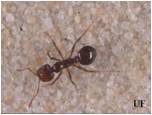Identification of Common Insect Pest in UF Housing
Kevyn Juneau, IPM Florida
Ants: Ants are social insects that have many workers and one to a few queens in their colonies. In your apartment, you will most often encounter the wingless workers trailing to a food source. These pests range in length from 1-6 mm.
Do not use your own pesticides on ants. This can cause a colony to divide into many colonies, making the problem worse. Ants require professional attention, so call the Department of Housing and Residence Education for free pest control.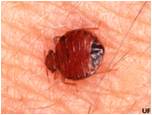
Bed bugs: Bed bugs are becoming a large problem in hotels and on campuses across America. These insects feed on people while they sleep. These bugs are wingless, flat, and oval-shaped. They are brownish-red in color and 4-5 mm long.
If these insects are not eradicated immediately when discovered they can become a huge problem and spread to other apartments. If you see bed bugs in your apartment immediately contact the Department of Housing and Residence Education for free pest control. It takes a professional to get rid of bed bugs.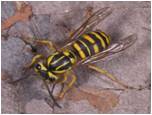
Bees and wasps: These are beneficial insects in the wild because they prey on pest insects and pollinate plants. They are flying insects 12-35 mm long often with yellow and black markings. Bees appear fuzzy while wasps are not.
These insects can sting and many people have bee and wasp allergies, but they can simply be avoided unless they are building a nest close to human activity. If you notice nests above your doorway, on playground equipment, or any other place where the wasps and bees can interfere with human activity, call the Department of Housing and Residence Education for free pest control. If a bee or wasp enters your apartment you can kill it with a fly swatter and remove it with a vacuum cleaner or paper towel.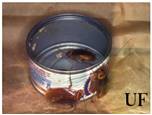
Cockroaches: Cockroaches are oval-shaped insects with long antennae. They come out at night and often are seen in the kitchen or bathroom. These insects have wings, but cannot fly well. The American and German cockroaches are the most common cockroach pests on campus.

American cockroaches: The large reddish-brown adults are up to 4 cm long. Each has a light colored ring on its body behind its head. These pests can come into your apartment through openings to the outdoors and also from the sewers.
German cockroaches: This pest is 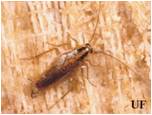 lighter in color and smaller than the American cockroach, about 1.5 cm long as an adult. It has two black stripes on its body behind its head. These pests are unknowingly brought into an apartment by either residents or guests and can spread from one apartment to another.
lighter in color and smaller than the American cockroach, about 1.5 cm long as an adult. It has two black stripes on its body behind its head. These pests are unknowingly brought into an apartment by either residents or guests and can spread from one apartment to another.
Cockroaches can be sprayed with soap and water and wiped up. If you see cockroaches in your apartment, call the Department of Housing and Residence Education for free pest control.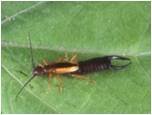
Earwigs: These brown insects are between 5-16 mm in length and have "pinchers" at the end of their abdomens. Earwigs are most often found outside in mulch, but can occasionally invade your apartment.
If you see earwigs in your apartment, you can spray them with soap and water and wipe them up.
Flies: As adults, these pests have two wings and are able to fly.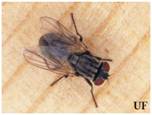 Immature flies are called maggots and need rotting organic matter to live. The most common indoor fly pests include house flies and fruit flies.
Immature flies are called maggots and need rotting organic matter to live. The most common indoor fly pests include house flies and fruit flies.
House flies: Adults are grey with black stripes. They are up to 7 mm long. Their larvae (maggots) are white and 3-5 mm long.
Fruit flies: These insects are very small, yellowish-brown flies with red eyes. They are less than 4 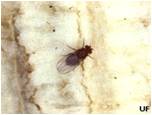 mm long. These flies are most often seen on and around fruit, dirty dishes, and garbage cans.
mm long. These flies are most often seen on and around fruit, dirty dishes, and garbage cans.
Large numbers of house flies and fruit flies often are seen in apartments with rotting food on the counters, on dirty dishes, or in the garbage. Cleaning spilled food or beverages, taking out the trash regularly, cleaning the dishes, and storing all fruit in the refrigerator will help prevent fly infestations. Flies can be sprayed with soap and water and wiped up. Fly swatters also work well to kill house flies.
Silverfish: Silverfish are grey, carrot-shaped insects. They are 12-19 mm in length and have long 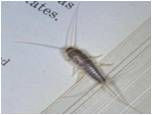 antennae and three long bristle-like tails.
antennae and three long bristle-like tails.
They can be found throughout an apartment but prefer areas with high moisture. They feed on fabric and paper.
The easiest way to eliminate silverfish is to reduce moisture in your apartment and remove any food source. Do not let water pool on the bathroom floors, clean up water behind sinks, and run the air conditioner to reduce the humidity. Store paper and any fabric in airtight plastic containers. When you see silverfish, they can be wiped up after being sprayed with soap and water. 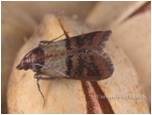
Stored product pests: There are many different types of stored product pests. The most common on campus include moths and weevils. These pests are brought home from the grocery stores in contaminated food, often in dried beans and corn, grains, or rice. One species of weevil, the sweet potato weevil, infests sweet potatoes.
Moths: Moth caterpillars range in length from the 7 mm grain moth 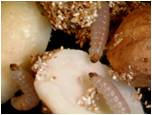 up to the larger 12 mm Indianmeal moth. These cream-colored caterpillars can be mistaken for maggots. Maggots will not be found in dry foods. The caterpillars become yellowish-brown flying adults, which are 2.5 cm in length.
up to the larger 12 mm Indianmeal moth. These cream-colored caterpillars can be mistaken for maggots. Maggots will not be found in dry foods. The caterpillars become yellowish-brown flying adults, which are 2.5 cm in length.
Weevils: Stored product weevils are small beetles with long snouts. These insects are smaller  than the moths, being 2-4 mm in length. They are brown or black in color. This insect drills holes in beans and corn to insert its eggs.
than the moths, being 2-4 mm in length. They are brown or black in color. This insect drills holes in beans and corn to insert its eggs.
Check any beans, grains, and rice for insects at the store before you purchase them. Infested sweet potatoes will have many holes in it. Do not purchase food if you notice any insects in the packages or on produce.
Remember, report any insect problems to the Department of Housing and Residence Education by sending an online H.A.W.K. request at www.housing.ufl.edu or fill out a work order and drop it off at the office.
Insect collection
Collecting the pest insects in your apartment will allow the pest control technician to identify them and properly decide how to treat the problem.
You can help by following these tips:
- Kill the insect with soap and water. Do not squash any insect to be identified.
- Place the insect into a storage container. Plastic food containers or plastic zip-up bags work well. You can use a tissue, or tweezers to pick up the insect if you do not want to touch it.
- Write the location where you found the insect on a piece of paper and place it into the container. For example write "found on the kitchen counter."
- Store the container with the insect in the freezer. This will preserve the insect so the pest control technician can make an accurate identification.
- Fill out a work order or H.A.W.K. request for free pest control.
- Give the collected insect to the pest control technician.



